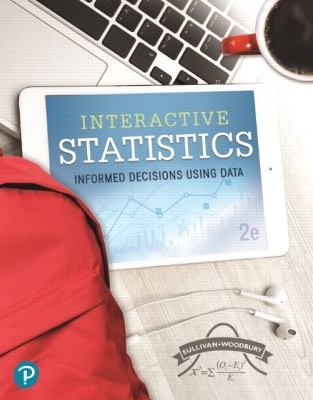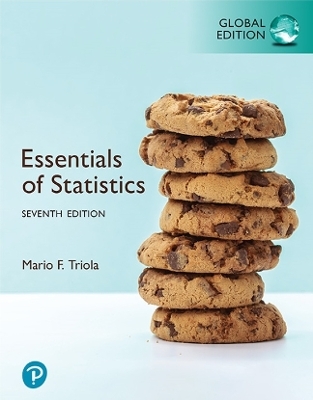
MyLab Statistics -- 24 Month Access Code -- for Interactive Statistics
Pearson (Hersteller)
978-0-13-467352-3 (ISBN)
- Titel z.Zt. nicht lieferbar
- Versandkostenfrei
- Auch auf Rechnung
- Artikel merken
Used books, rentals, and purchases made outside of Pearson
If purchasing or renting from companies other than Pearson, the access codes for the MyLab platform may not be included, may be incorrect, or may be previously redeemed. Check with the seller before completing your purchase.
For courses in Introductory Statistics.
This package includes MyLab Statistics.
Go INTERACTIVE with Sullivan/Woodbury’s Interactive Statistics
Interactive Statistics: Informed Decisions Using Data presents content in a way that gets students actively doing statistics as they learn new concepts. Written entirely in MyLab™ Statistics, Interactive Statistics engages students by combining text, multimedia, and assessment into one seamless learning experience: Interactive Assignments. Through a series of Interactive Assignments, students are encouraged to experience statistics in new and dynamic ways.
Authors Mike Sullivan and George Woodbury are both active in the classroom, and they incorporate ideas and strategies from their experience teaching today’s students. Their practical approach paired with the interactive, guided learning environment helps improve students’ conceptual understanding, knowledge retention, and ability to see how statistics is connected to the world at large.
Personalize learning with MyLab Statistics
By combining trusted author content with digital tools and a flexible platform, MyLab personalizes the learning experience and improves results for each student. With MyLab Statistics and StatCrunch, an integrated web-based statistical software program, students learn the skills they need to interact with data in the real world.
0134673522 / 9780134673523 Interactive Statistics: Informed Decisions Using Data Student Access Kit, 2/e
About our authors Michael Sullivan, III has training in mathematics, statistics and economics, with a varied teaching background that includes 27 years of instruction in both high school- and college-level mathematics. He is currently a full-time professor of mathematics at Joliet Junior College. Michael has numerous textbooks in publication, including an Introductory Statistics series and a Precalculus series which he writes with his father, Michael Sullivan. Michael believes that his experiences writing texts for college-level math and statistics courses give him a unique perspective on where students are headed once they leave the developmental mathematics tract. This experience is reflected in the philosophy and presentation of his developmental text series. When not in the classroom or writing, Michael enjoys spending time with his 3 children, Michael, Kevin and Marissa, and playing golf. Now that his 2 sons are getting older, he has the opportunity to do both at the same time! George Woodbury earned a bachelor's degree in Mathematics from the University of California - Santa Barbara and a master's degree in Mathematics from California State University - Northridge. He currently teaches at College of the Sequoias in Visalia, CA, just outside of Fresno. George has been honored as an instructor by both his students and his colleagues. Aside from teaching and writing, George served as the department chair of the math/engineering division from 1999 through 2004. He has been a user of MyLab Math and MyLab Statistics since inception, continually coming up with creative ways to integrate his teaching methods with technology. He actively blogs his thoughts on math, statistics, teaching and study skills.
I: GETTING THE INFORMATION YOU NEED
Data Collection
1.1 Introduction to the Practice of Statistics
1.2 Observational Studies versus Designed Experiments
1.3 Simple Random Sampling
1.4 Other Effective Sampling Methods
1.5 Bias in Sampling
1.6 The Design of Experiments
Chapter Review
Chapter Test
Making an Informed Decision: What College Should I Attend?
Case Study: Chrysalises for Cash
II: DESCRIPTIVE STATISTICS
Organizing and Summarizing Data
2.1 Organizing Qualitative Data
2.2 Organizing Quantitative Data: The Popular Displays
2.3 Additional Displays of Quantitative Data
2.4 Graphical Misrepresentations of Data
Chapter Review
Chapter Test
Making an Informed Decision: Tables or Graphs?
Case Study: The Day the Sky Roared
Numerically Summarizing Data
3.1 Measures of Central Tendency
3.2 Measures of Dispersion
3.3 Measures of Central Tendency and Dispersion from Grouped Data
3.4 Measures of Position
3.5 The Five-Number Summary and Boxplots
Chapter Review
Chapter Test
Making an Informed Decision: What Car Should I Buy?
Case Study: Who Was “A Mourner”?
Describing the Relation Between Two Variables
4.1 Scatter Diagrams and Correlation
4.2 Least-Squares Regression
4.3 Diagnostics on the Least-Squares Regression Line
4.4 Contingency Tables and Association
Chapter Review
Chapter Test
Making an Informed Decision: Relationships Among Variables on a World Scale
Case Study: Thomas Malthus, Population, and Subsistence
III: PROBABILITY AND PROBABILITY DISTRIBUTIONS
Probability
5.1 Probability Rules
5.2 The Addition Rule and Complements
5.3 Independence and the Multiplication Rule
5.4 Conditional Probability and the General Multiplication Rule
5.5 Counting Techniques
5.6 Simulation
5.7 Putting It Together: Which Method Do I Use?
Chapter Review
Chapter Test
Making an Informed Decision: What Are the Effects of Drinking and Driving?
Case Study: The Case of the Body in the Bag
Discrete Probability Distributions
6.1 Discrete Random Variables
6.2 The Binomial Probability Distribution
6.3 The Poisson Probability Distribution
Chapter Review
Chapter Test
Making an Informed Decision: Should We Convict?
Case Study: The Voyage of the St. Andrew
The Normal Probability Distribution
7.1 Properties of the Normal Distribution
7.2 Applications of the Normal Distribution
7.3 Assessing Normality
7.4 The Normal Approximation to the Binomial Probability Distribution
Chapter Review
Chapter Test
Making an Informed Decision: What Stock Do I Pick?
Case Study: A Tale of Blood, Chemistry, and Health
IV: INFERENCE – FROM SAMPLES TO POPULATION
Sampling Distributions
8.1 Distribution of the Sample Mean
8.2 Distribution of the Sample Proportion
Chapter Review
Chapter Test
Making an Informed Decision: How Would You Break Down Your Day?
Case Study: Sampling Distribution of the Median
Estimating the Value of a Parameter Using Confidence Intervals
9.1 Estimating a Population Proportion
9.2 Estimating a Population Mean
9.3 Putting It Together: Which Procedure Do I Use?
9.4 Estimating with Bootstrapping
Chapter Review
Chapter Test
Making an Informed Decision: How Much Should I Spend for this House?
Case Study: When Model Requirements Fail
Hypothesis Tests Regarding a Parameter
10.1 The Language of Hypothesis Testing
10.2A Hypothesis Tests on a Population Proportion with Simulation
10.2B Hypothesis Tests on a Population Proportion Using the Normal Model
10.3A Using Simulation/Bootstrapping in Hypothesis Tests for a Population Mean
10.3B Hypothesis Tests for a Population Mean
10.4 Putting It Together: Which Procedure Do I Use?
Chapter Review
Chapter Test
Making an Informed Decision: Selecting a Mutual Fund
Case Study: How Old Is Stonehenge?
Inference on Two Samples
11.1A Using Randomization Techniques to Compare Two Proportions
11.1 Inference about Two Population Proportions: Independent Samples
11.2A Using Bootstrapping to Conduct Inference on Two Dependent Means
11.2 Inference about Two Population Means: Dependent Samples
11.3A Using Randomization Techniques to Compare Two Independent Means
11.3 Inference about Two Population Means: Independent Samples
11.4 Putting It Together: Which Procedure Do I Use?
Chapter Review
Chapter Test
Making an Informed Decision: Which Car Should I Buy?
Case Study: Control in the Design of Experiment
Inference on Categorical Data
12.1 Goodness-of-Fit Test
12.2 Tests for Independence and the Homogeneity of Proportions
12.3 Inference about Two Population Proportions: Dependent Samples
Chapter Review
Chapter Test
Making an Informed Decision: What Are the Benefits of College?
Case Study: Feeling Lucky? Well, Are You?
Comparing Three or More Means
13.1 Comparing Three or More Means: One-Way Analysis of Variance
13.2 Post-Hoc Tests on One-Way Analysis of Variance
Chapter Review
Chapter Test
Making an Informed Decision: Where Should I Invest?
Case Study: Hat Size and Intelligence
Inference of the Least-Squares Regression Model
14.1A Using Randomization Techniques on the Slope of the Least-Squares Regression Line
14.1 Testing the Significance of the Least-Squares Regression Model
14.2 Confidence and Prediction Intervals
Chapter Review
Chapter Test
Making an Informed Decision: Buying a Home
Case Study: Housing Boom
APPENDICES
A. Tables
B. Lines
C. Additional Topics
C.1 The Normal Approximation to the Binomial Probability Distribution
C.2 Estimating a Population Standard Deviation
C.3 Hypothesis Tests for a Population Standard Deviation
| Sprache | englisch |
|---|---|
| Maße | 216 x 279 mm |
| Gewicht | 14 g |
| Themenwelt | Mathematik / Informatik ► Mathematik ► Statistik |
| ISBN-10 | 0-13-467352-2 / 0134673522 |
| ISBN-13 | 978-0-13-467352-3 / 9780134673523 |
| Zustand | Neuware |
| Haben Sie eine Frage zum Produkt? |
aus dem Bereich
